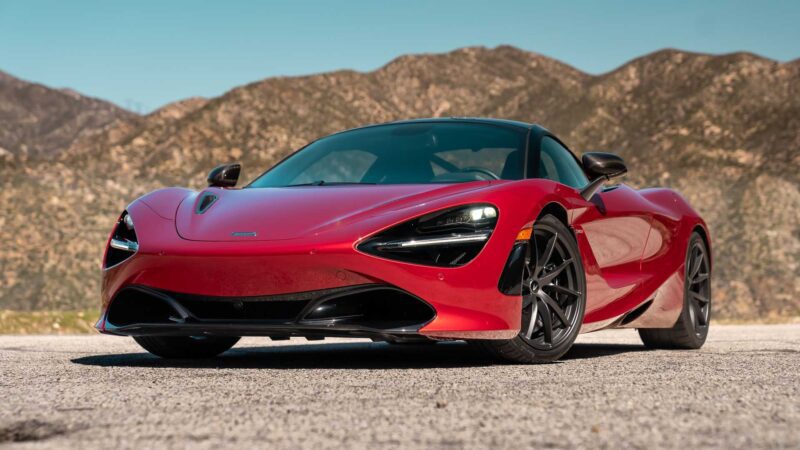The McLaren 720S is dead. Its production line shut down at the end of last year, and a replacement is due soon. So why have I spent a few days behind the wheel of a discontinued supercar? Firstly, because McLaren offered. But more importantly, the 720S, in many ways, is still a benchmark in the supercar world, despite being over five years old. So instead of reviewing a car I tested last year that you can’t buy anymore, I’d like to tell you about the 720S and why it’s still so special.
First, we must look at where the 720S came from because McLaren didn’t nail the modern supercar formula on its first try. In 2011, when the 12C went into production, it did so against stiff competition from Ferrari and Lamborghini. The 458 Italia, arguably the best NA V8 Ferrari ever, had debuted only a few years earlier. Meanwhile, Lamborghini was pumping out as many special Gallardos as it could think up.
So in comes the 12C with a new approach. Its engine was turbocharged, its structure made of carbon fiber, and its suspension soft and compliant. It had all the right pieces but couldn’t assemble them and was criticized in period for being serious and clinical. The 650S followed shortly with a face styled by legendary designer Frank Stephenson, developed more power from its compact 3.8-liter engine, and added track-focused special editions like the 675 LT. The 650S was a step in the right direction, but it couldn’t fully fix the 12C’s core issues and was only around for three years.
McLaren’s breakthrough moment in my eyes came in 2017 with the unveiling of the 720S during that year’s Geneva Motor Show. When the covers came off, it looked nothing like what I expected. The British carmaker was no longer playing it safe, and the 720S’ intricate styling reflected that. Its headlights doubled as air intakes, its doors made up parts of its roof, and with 710 horsepower, it was hell-bent on not just outgunning the supercars of the time but bullying hypercars too.
It didn’t take long for videos like those published by DragTimes to start surfacing on the web, showing 720S’ running much quicker quarter mile and launch times than advertised. McLaren had leapfrogged the competition, and neither Ferrari nor Lamborghini had an answer. The 720S shifted McLaren’s view in the public eye from a maker of technically impressive cars to a creator of proper bedroom wall poster-worthy dream machines.
At the core of what makes the 720S special is its carbon-fiber monocoque. It’s light and robust, and with thin A-pillars and see-through C-pillars, it allows for excellent visibility. Combined with low door sills for easy entry and plush suspension, this is the definition of a daily drivable supercar. However, its structure is so strong, in fact, that McLaren didn’t need to reinforce it when developing the spider. And while the 720S also saw more powerful LT variants, this core structure, and model laid the foundation for special editions like the Senna, Elva, Speedtail, and Sabre.
We can’t, of course, its engine, which grew to 4.0 liters from the 650S’ 3.8. It develops 710 hp and 568 lb-ft of torque, which at the time of its debut was 49 more than a 488 GTB and 108 more than a Huracan. It lags considerably at lower rpms, but once its two turbochargers get going, it delivers torque overload and terrifying acceleration.
There’s no arguing its performance; it’s in the numbers. But this is perhaps the part I like least about the car. Its dual-clutch transmission, which sends power to the rear, is quick and responsive, its hydraulic steering is communicative, and its mechanical brakes engaging. Its engine, however, sounds muffled, lags way too much, and isn’t all that satisfying to rev out. It’s scary fast, but am I having fun? Not as much as in an NA Lambo, that’s for sure.
While the 720S’ acceleration figures cemented its spot in the hearts of enthusiasts, it’s how it behaves on a twisty road that impresses most. It’s agile, responsive, and one of the few modern supercars that’s genuinely engaging. I was thrilled last year when I drove the Artura out in Death Valley and was met with the same excellent steering, brake, and suspension system that makes its larger sibling such a joy to drive.
At this point, I’ll address the elephant in the room, which is the 720S’ interior. McLaren makes exciting cars, not luxurious ones; this cabin is a perfect example of that. While it’s covered in various suede and leather surfaces, its tech is showing its age five years on. This model may be out of production, but the car I tested was still a 2022. And for a vehicle this new to lack Apple CarPlay, Android Auto, and basic safety features is surprising.
Thankfully, its seats are comfortable and supportive, and the cabin layout isn’t cluttered with unnecessary buttons. If it nailed its tech details, I’d be out of things to complain about.
So the McLaren 720S is dead, and its successor is due any day now. Its story is one of being the right product that arrived at the right time. When it debuted, supercars weren’t this quick. Now all of them have to be. It wasn’t a painless ascension, as McLaren’s reliability issues are far from uncommon. But as I learned during my first drive of the Artura last year, the British carmaker is firmly focused on improving in these areas.
While McLaren has yet to announce details about its replacement, recent spy shots reveal a car not too different from the current model. If the jump to the future is more of a hop, like from 12C to 650S, let it improve in the tech department and keep the driving experience as fun and engaging as in its predecessor. This isn’t the time to mess with a great thing.
